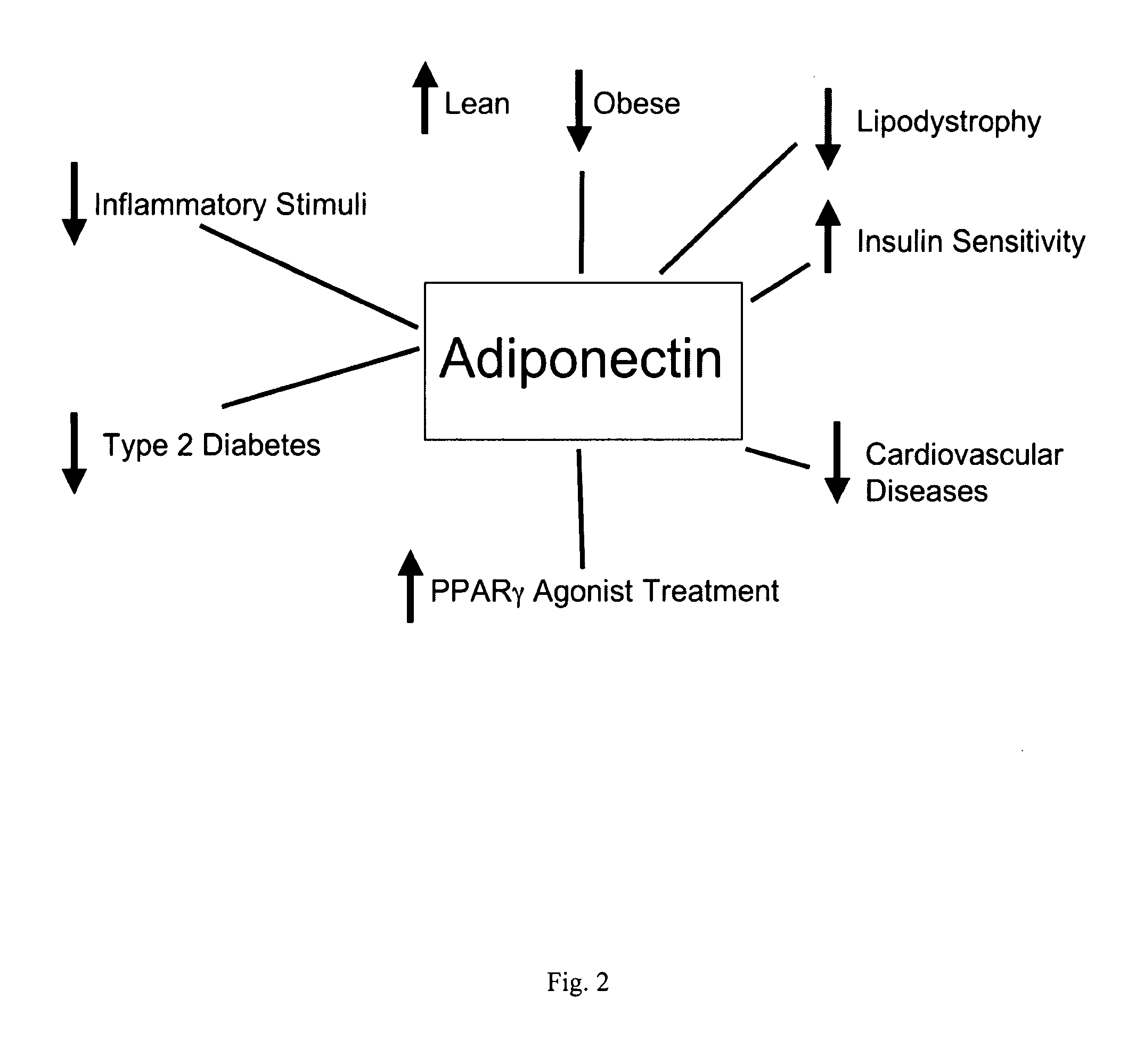Methods for the treatment of HIV-1 related fat maldistribution, fasting hyperlipidemia and modification of adipocyte physiology
a hiv-1 related fat and fasting hyperlipidemia technology, applied in the direction of drug composition, peptide/protein ingredients, metabolic disorders, etc., can solve the problems of monotherapy failing to adequately control the myriad of metabolic imbalances, increasing the rate of obesity with time, and preventing or normalizing lipoatrophy. , to achieve the effect of increasing serum lipids, preventing or normalizing lipoatrophy, and treating obesity
- Summary
- Abstract
- Description
- Claims
- Application Information
AI Technical Summary
Benefits of technology
Problems solved by technology
Method used
Image
Examples
example 1
Increased Lipogenesis in 3T3-L1 Adipocytes Elicited by a CLA Formulation and Components
[0137] The Model—The 3T3-L1 murine fibroblast model is used to study the potential effects of compounds on adipocyte differentiation and adipogenesis. This cell line allows investigation of stimuli and mechanisms that regulate preadipocytes replication separately from those that regulate differentiation to adipocytes [Fasshauer, M., Klein, J., Neumann, S., Eszlinger, M., and Paschke, R. Hormonal regulation of adiponectin gene expression in 3T3-L1 adipocytes. Biochem Biophys Res Commun, 290: 1084-1089, (2002); Li, Y. and Lazar, M. A. Differential gene regulation by PPARgamma agonist and constitutively active PPARgamma2. Mol Endocrinol, 16: 1040-1048, (2002)] as well as insulin-sensitizing and triglyceride-lowering ability of the test agent [Raz, I., Eldor, R., Cernea, S., and Shafrir, E. Diabetes: insulin resistance and derangements in lipid metabolism. Cure through intervention in fat transport a...
example 2
Increased Adiponectin Secretion in the TNFα / 3T3-L1 Adipocyte Model by BION493 and Components
[0152] The Model—The 3T3-L1 murine fibroblast model as described in Example 1 was used in these experiments.
[0153] Cell Culture and Treatment—Cell culture procedures and standard chemicals, and statistical procedures used were as noted in Example 1. BION 493 as described in Example 1 was used as the test material and dosed at 100, 50, 25 and 12.5 μg BION493 / mL. This corresponded to 21.4, 10.7 and 5.4 μg CLA / mL, 3.8, 1.9 and 1.0 μg NAC / mL and 0.0007, 0.0004 and 0.0002 μg Cr+++ / mL. Concentrations for the positive control pioglitazone were 2.5, 1.25 and 0.625 μg / mL. The processes of cell culture and treatment for assessing effect of the test materials on adiponectin secretion in the presence of TNFα are presented schematically in FIG. 9. Test materials were added four hours prior to the addition of TNFα at a concentration of 10 ng / mL. Following overnight incubation, the supernatant media was s...
example 3
Decreased IL-6 Secretion in the TNFα / 3T3-L1 Adipocyte Model by a CLA Formulation and Components
[0158] The Model—The 3T3-L1 murine fibroblast model as described in Example 1 was used in these experiments.
[0159] Cell Culture and Treatment—Cell culture procedures and standard chemicals, and statistical procedures used were as noted in Example 1. BION 493 as described in Example 1 was used as the test material and dosed at 100, 50, 25 and 12.5 μg BION493 / mL. This corresponded to 21.4, 10.7 and 5.4 μg CLA / mL, 3.8, 1.9 and 1.0 μg NAC / mL and 0.0007, 0.0004 and 0.0002 μg Cr+++ / mL. CLA as described in Example 1 was dosed at 50, 25 and 12.5 μg / mL. All positive controls troglitazone, rosiglitazone and pioglitazone were tested at 5.0 μg / mL. The processes of cell culture and treatment for assessing effect of the test materials on IL-6 secretion in the presence of TNFα are presented schematically in FIG. 9. Test materials were added four hours prior to the addition of TNFα at a concentration of...
PUM
| Property | Measurement | Unit |
|---|---|---|
| fat mass | aaaaa | aaaaa |
| fat mass | aaaaa | aaaaa |
| concentrations | aaaaa | aaaaa |
Abstract
Description
Claims
Application Information
 Login to View More
Login to View More - R&D
- Intellectual Property
- Life Sciences
- Materials
- Tech Scout
- Unparalleled Data Quality
- Higher Quality Content
- 60% Fewer Hallucinations
Browse by: Latest US Patents, China's latest patents, Technical Efficacy Thesaurus, Application Domain, Technology Topic, Popular Technical Reports.
© 2025 PatSnap. All rights reserved.Legal|Privacy policy|Modern Slavery Act Transparency Statement|Sitemap|About US| Contact US: help@patsnap.com



